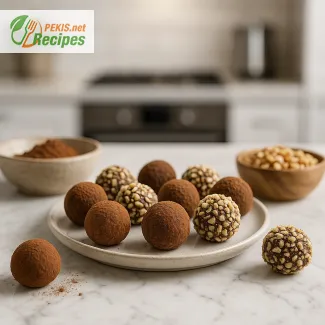
When it comes to elevating desserts to a luxurious level of indulgence, few ingredients can match the sophistication and versatility of almond cream. This classic creation, also known as crème d’amande in French patisserie, has been a cornerstone in fine baking for centuries. Its rich, nutty flavor and silky smooth texture make it the ideal filling or topping for a variety of confections, from elegant tarts to flaky pastries. Whether you're a seasoned baker or an aspiring enthusiast, mastering almond cream will open the door to a world of culinary creativity.
What Makes Almond Cream Irresistible?
The secret lies in its balanced simplicity. At its core, almond cream is a blend of ground almonds, sugar, butter, eggs, and a touch of flour for structure. But the magic happens in how these humble ingredients come together to create a luscious, velvety consistency that melts in your mouth. The natural sweetness of almonds is complemented by the creamy richness of butter, while the eggs provide a custard-like base that enhances its luxurious texture.
This combination not only delivers a sophisticated flavor profile but also offers a versatility that makes almond cream a must-have in any baker's repertoire.
A Staple in Classic Desserts
Almond cream is a vital component in some of the world’s most beloved desserts. From the flaky galette des rois to the delicate pithiviers, this versatile filling brings depth and complexity to every bite. Imagine a golden-brown tart crust cradling a layer of almond cream, topped with seasonal fruits like apricots, pears, or plums. The result is a dessert that is visually stunning and bursting with flavor.
Beyond tarts, almond cream is the secret ingredient in many iconic French pastries. Its ability to hold its shape when baked makes it perfect for fillings, ensuring a moist, flavorful interior without overwhelming the pastry. Even in contemporary baking, almond cream is a favorite for creating modern, elegant treats like almond croissants, frangipane-stuffed brioche, or layered entremets.
Nutritional Richness Meets Decadence
While almond cream is undeniably indulgent, it also boasts a variety of nutritional benefits. Almonds are a rich source of healthy fats, protein, and essential nutrients such as vitamin E, magnesium, and antioxidants. These nutrients support heart health, skin vitality, and overall well-being, making almond cream not just a treat for the palate but also a source of nourishment when enjoyed in moderation. Its naturally gluten-free nature (with slight adjustments) also caters to those with dietary restrictions, further broadening its appeal.
Tips for Perfect Almond Cream Every Time
Crafting the ideal almond cream requires attention to detail and a few insider tips:
- Quality ingredients are key – Use fresh, high-quality almonds and unsalted butter for the best flavor. If possible, opt for blanched almonds or almond flour to achieve a smoother consistency.
- Room temperature ingredients – Ensure all your ingredients are at room temperature before blending. This ensures a smooth mixture and prevents curdling.
- Don’t overmix – While it’s important to blend the ingredients well, overmixing can lead to a dense, overly heavy cream. Aim for a light and airy texture.
- Enhance with flavor – Add a splash of almond extract, vanilla, or even citrus zest to elevate the flavor profile of your cream.
Endless Possibilities with Almond Cream
The beauty of almond cream lies in its adaptability. Use it as a standalone filling for a tart shell, or layer it with chocolate, pastry cream, or fruit compote for added complexity. Pair it with puff pastry for a luxurious almond turnover or pipe it into éclairs for a nutty twist on a classic. Its subtle elegance ensures that it complements, rather than overpowers, other elements of your dessert.
For those who love to experiment, almond cream can also serve as a base for creating other variations. Blend it with pistachios for a vibrant green pistachio cream or mix in cocoa powder for a decadent chocolate-almond filling. The possibilities are as endless as your imagination.
A Must-Have Recipe for Bakers Everywhere
Whether you’re preparing for a special occasion or simply indulging in a quiet weekend baking project, almond cream is the perfect way to elevate your creations. Its timeless elegance and rich, nutty profile make it a favorite among professional chefs and home bakers alike. So why wait? Discover the magic of almond cream and unlock a new level of culinary artistry.
This creamy, nutty delight is more than just a recipe; it’s a gateway to creating desserts that are as beautiful as they are delicious. Transform your baking with almond cream and leave a lasting impression on everyone lucky enough to taste your creations.
- Prepare Ingredients: Ensure the butter is softened to room temperature. Pre-measure all ingredients for a smoother process.
- Cream Butter and Sugar: In a mixing bowl, beat the softened butter and granulated sugar together until the mixture becomes pale and fluffy.
- Incorporate Eggs: Gradually add the eggs, one at a time, mixing thoroughly after each addition. This ensures a smooth and even mixture.
- Add Dry Ingredients: Mix in the ground almonds, followed by the plain flour (if using). Stir until fully incorporated. Add a pinch of salt and almond extract if desired.
- Final Texture: The almond cream should be smooth, creamy, and ready to use as a filling or spread.
- Chill (Optional): For a firmer texture, refrigerate the almond cream for about 30 minutes before using it.
Cooking Tips:
- Use the almond cream immediately as a filling in tarts or pastries.
- When baking, ensure the oven temperature is appropriate for your pastry or tart (typically 180°C/350°F) and bake until the cream sets and turns golden.
Preparation Time:
- Active preparation: 15 minutes
- Cooking time: Depends on the recipe in which almond cream is used (typically 20–30 minutes when baked in a tart).
- Total time: 15 minutes (excluding chilling or additional baking).
Enhancing the Almond Cream Recipe: Expert Tips for Perfect Results
Almond cream, with its nutty richness and velvety texture, is a cornerstone of fine baking. While the original recipe is a timeless classic, there are numerous ways to adapt and refine it to suit different tastes, dietary needs, and culinary ambitions. Below is a detailed exploration of tips, tricks, and substitutions to take your almond cream recipe to the next level.
1. Elevating the Flavor Profile
a. Enhance the Almond Essence
- Toasted Almonds: Toast the ground almonds lightly in a dry pan or oven before incorporating them into the recipe. This deepens the nutty flavor and adds a subtle complexity.
- Almond Extract: While the recipe suggests almond extract as optional, adding a high-quality extract amplifies the almond flavor without altering the texture. A drop or two is enough to create a more aromatic cream.
b. Introduce Complementary Flavors
- Vanilla Bean Paste: Adding 5 ml (1 tsp) of vanilla bean paste enhances the cream's sweetness and aroma, balancing the nuttiness of almonds.
- Citrus Zest: Grate the zest of an orange or lemon into the mixture for a bright, refreshing note.
- Alcohol Infusions: A tablespoon of amaretto, rum, or kirsch can bring sophistication to the cream, especially for festive desserts.
c. Pair with Other Nuts
- Swap 20–30% of the ground almonds with ground hazelnuts or pistachios for a unique twist. This modification also alters the color and creates a more distinctive nut profile.
2. Improving Texture
a. Achieve Creamier Consistency
- Double-Blending: Pulse the ground almonds in a food processor to create an even finer powder. This ensures a smoother cream.
- Cream Cheese Addition: For a silkier texture, replace 20 g of butter with cream cheese. This also adds a subtle tang that complements the sweetness.
b. Reducing Graininess
- Use blanched almonds to avoid the slight bitterness and grainy texture that almond skins can introduce. For ultra-smooth almond cream, sift the almond meal before mixing.
3. Adjusting Sweetness Levels
a. Less Sweet Variations
- Reduce the sugar content to 80 g (2.8 oz) for a more subtle sweetness. This adjustment is ideal when pairing the cream with sweet fruits like ripe peaches or figs.
b. Alternative Sweeteners
- Honey: Replace granulated sugar with honey for a floral sweetness and a slightly softer texture.
- Coconut Sugar: For a caramel-like undertone, substitute granulated sugar with coconut sugar, though this will darken the cream slightly.
4. Adapting for Dietary Restrictions
a. Gluten-Free Version
- Omit the flour entirely or replace it with 15 g (1 tbsp) of almond flour or a certified gluten-free blend. This maintains the structure without compromising texture.
b. Dairy-Free Version
- Substitute butter with equal parts vegan margarine or refined coconut oil. The coconut oil should be solid at room temperature for the best results.
c. Egg-Free Version
- Use 3 tablespoons of aquafaba (the liquid from canned chickpeas) per egg as a substitute. Another alternative is a commercial egg replacer or flaxseed gel (1 tbsp ground flaxseed + 3 tbsp water per egg).
d. Sugar-Free Option
- Opt for erythritol or stevia in place of sugar for a keto-friendly version. Note that these substitutes may affect the cream's consistency, so blending thoroughly is crucial.
5. Customizing for Specific Uses
a. For Pastries
- Add an extra 10 g (1 tbsp) of plain flour for a firmer cream that holds up better in turnovers or Danish pastries.
b. As a Tart Filling
- Incorporate 50 g of pastry cream for a richer, more custard-like filling. This combination works wonderfully with fruit toppings.
c. As a Frosting
- Whip the prepared almond cream with 50 g (1.8 oz) of softened cream cheese or mascarpone for a spreadable frosting ideal for cakes or cupcakes.
6. Balancing Nutritional Profiles
a. Adding Protein
- Mix in 20 g (2 tbsp) of protein powder, such as almond or vanilla-flavored whey, for a nutrient boost without altering the flavor.
b. Reducing Fat
- Replace 50 g of butter with unsweetened applesauce for a lower-fat alternative. While the texture will be softer, the flavor remains intact.
7. Storage and Shelf Life Tips
a. Refrigeration
- Store almond cream in an airtight container in the fridge for up to 3 days. Before using, bring it to room temperature and re-whip to restore its smooth texture.
b. Freezing
- Almond cream freezes exceptionally well. Divide it into portions and freeze for up to 3 months. Thaw overnight in the fridge and mix thoroughly before use.
8. Presentation Tips
a. As a Tart Base
- Spread almond cream evenly over a pre-baked tart shell before adding fruit toppings. For a glossy finish, brush the fruit with apricot glaze.
b. In Pastries
- Pipe almond cream into croissants or turnovers, ensuring an even distribution. Sprinkle with sliced almonds for added texture.
c. Standalone Dessert
- Serve the cream chilled in dessert cups, garnished with crushed amaretti biscuits and a drizzle of honey.
9. Troubleshooting Common Issues
a. Grainy Texture
- This may result from overmixing or using coarse almond meal. Use finer almond flour and mix just until combined.
b. Separation
- If the cream appears curdled, the butter may have been too cold. Bring all ingredients to room temperature before mixing.
c. Overly Sweet Cream
- Balance sweetness by adding a pinch of salt or a few drops of lemon juice.
10. Inspiration for Creative Applications
- Seasonal Tarts: Pair with summer fruits like cherries or autumnal favorites like poached pears.
- Layered Cakes: Use almond cream as a filling between layers of sponge cake.
- Breakfast Pastries: Incorporate into brioche or danishes for a decadent morning treat.
With these tips, you can transform the classic almond cream recipe into a versatile base for countless creations. Whether you’re aiming for traditional elegance or modern innovation, almond cream offers endless possibilities to delight the senses. Experiment boldly and enjoy the journey of perfecting your almond cream!
- Contains nuts (almonds), eggs, and dairy (butter).
- May contain gluten if plain flour is used. Substitute with gluten-free flour to make it gluten-free.
Substitution Tips for Allergens and Gluten:
- Replace butter with dairy-free margarine or coconut oil for a dairy-free version.
- Use gluten-free flour to eliminate gluten.
- For an egg-free version, use a commercial egg replacer or aquafaba (3 tbsp per egg).
- Vitamin E: 3.2 mg (22% of daily intake) – supports skin health and immune function.
- Magnesium: 32 mg (8% of daily intake) – important for muscle function and energy production.
- Calcium: 22 mg (2% of daily intake) – aids in bone strength.
- Iron: 0.8 mg (5% of daily intake) – essential for oxygen transport in the body.
- Vitamin E: As a natural antioxidant, it combats free radicals, reducing inflammation and supporting overall health.
- Polyphenols from almonds: Estimated 0.4 mg – may improve heart health by reducing oxidative stress.





